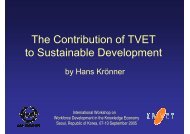Learning for Life, Work and the Future Initial ... - Unesco-Unevoc
Learning for Life, Work and the Future Initial ... - Unesco-Unevoc
Learning for Life, Work and the Future Initial ... - Unesco-Unevoc
Create successful ePaper yourself
Turn your PDF publications into a flip-book with our unique Google optimized e-Paper software.
Page 34 Participants’ Papers <strong>Learning</strong> <strong>for</strong> <strong>Life</strong>, <strong>Work</strong> <strong>and</strong> <strong>the</strong> <strong>Future</strong><br />
4. Effectiveness of Technology<br />
There is in <strong>the</strong> research literature a strong consensus<br />
that technology <strong>and</strong> technology-enhanced programmes<br />
can promote <strong>for</strong>ms of more engaged <strong>and</strong> active<br />
learning. However, <strong>the</strong> selection of <strong>the</strong> type of technology<br />
<strong>and</strong> its use is critical. Jones et al (1995)<br />
mentioned six indicators <strong>for</strong> high-technology per<strong>for</strong>mance<br />
in education:<br />
• Accessibility of <strong>the</strong> technology: <strong>the</strong> technologies<br />
<strong>and</strong> resources must be accessible to staff <strong>and</strong><br />
learners, both within <strong>the</strong> classrooms <strong>and</strong> beyond <strong>the</strong><br />
school<br />
• Operability of <strong>the</strong> technology: ease with which <strong>the</strong><br />
technology operates, i.e. <strong>the</strong> technical set-up of <strong>the</strong><br />
system<br />
• Organisation of <strong>the</strong> technology in terms of its<br />
location <strong>and</strong> distribution<br />
• ‘Engagability’, or <strong>the</strong> capacity of <strong>the</strong> technology to<br />
engage students in challenging learning<br />
• Ease of use: user-friendliness; fast, effective help;<br />
etc.<br />
• Functionali1ty, or <strong>the</strong> technology’s capacity to<br />
prepare students to use a variety of technological<br />
tools.<br />
5. Email in Teacher Training<br />
Email by itself is a low-per<strong>for</strong>mance technology<br />
because its sole function is communication. But email<br />
as a tool in teacher training can give student teachers<br />
access to rich learning experiences, such as communicating<br />
with tutors or mentors, consulting experts <strong>and</strong><br />
producing collaborative project work.<br />
6. Videos in Vocational Teacher Training<br />
Videos are an effective medium <strong>for</strong> professional<br />
development (Mateff) when used in an interactive way<br />
that promotes discussion. The traditional use of<br />
videos, whereby <strong>the</strong> technology is seen as a replacement<br />
<strong>for</strong> or supplementation of <strong>the</strong> teacher, can be<br />
qualified as low technology <strong>and</strong> results in most cases in<br />
passive <strong>for</strong>ms of learning. However, <strong>the</strong> very same<br />
technology can be used to create a much greater<br />
involvement of <strong>the</strong> learner in <strong>the</strong> learning process.<br />
Effective use of video material requires interactive<br />
viewing: stopping <strong>for</strong> reflection, discussion or practice<br />
of what has just been viewed. The actual practice of a<br />
skill just viewed should be as close as possible to <strong>the</strong><br />
actual viewing <strong>and</strong> <strong>the</strong>re<strong>for</strong>e requires careful planning.<br />
7. Need <strong>for</strong> (Regional) Video Production<br />
Given government’s commitment to enhance <strong>the</strong><br />
quality of education, funds should be made available<br />
<strong>for</strong> <strong>the</strong> ‘hardware’ side of creating modern technological<br />
classroom environments. The ‘software’ −<br />
i.e. video production appropriate <strong>for</strong> teacher training in<br />
<strong>the</strong> region − is more of a problem. This is not only a<br />
financial but also a human resource issue. A combined<br />
team consisting of video production experts <strong>and</strong><br />
teacher training facilitators would be needed. To make<br />
such an enterprise worthwhile, a regional approach is<br />
to be preferred over a local endeavour. Expert advice<br />
<strong>and</strong> support from outside <strong>the</strong> region might be needed,<br />
but should be related to capacity building in <strong>the</strong> region<br />
<strong>for</strong> educational video production.<br />
CTVE proposes that a project to produce videos <strong>for</strong><br />
teacher training is started in <strong>the</strong> region <strong>and</strong> funds are<br />
found <strong>for</strong> such a project.<br />
Although <strong>the</strong> above concentrates on <strong>the</strong> use of videos<br />
in <strong>the</strong> training of teachers, a similar need <strong>for</strong> good<br />
instructional video material exists at <strong>the</strong> Technical<br />
Colleges when offering <strong>the</strong> Botswana Technical<br />
Education Programme (BTEP).<br />
8. Interactive Videos (CD-ROMs)<br />
Videos as described above, both interactive <strong>and</strong> promoting<br />
discussion, are extremely useful tools in <strong>the</strong><br />
training of teachers when viewed in a group. However,<br />
<strong>the</strong>y have one specific weakness. Teaching is a<br />
decision-making activity. Teachers take decisions<br />
continuously during <strong>the</strong> facilitating of <strong>the</strong> learning of<br />
<strong>the</strong>ir students. Modern technology allows <strong>the</strong> production<br />
of interactive videos (tape or disk): a decision<br />
is required <strong>and</strong> <strong>the</strong> viewer/s is/are asked to take it.<br />
Based on <strong>the</strong> choice, <strong>the</strong> video continues. One can<br />
now go back to <strong>the</strong> decision point <strong>and</strong> view what<br />
would have happened if ano<strong>the</strong>r decision had been<br />
taken.<br />
Interactive multimedia allows <strong>the</strong> learner to interact<br />
with <strong>the</strong> in<strong>for</strong>mation provided through <strong>the</strong> computer.<br />
For teacher training, face-to-face or distance, this is a<br />
powerful learning tool. Interactive multimedia<br />
resources are also extremely useful <strong>for</strong> vocational<br />
education as <strong>the</strong>y allow learners to gain experience<br />
through simulations of situations that would normally<br />
be inaccessible to <strong>the</strong>m because of safety factors,<br />
security factors or costs. It has been established that<br />
<strong>the</strong> appropriate use of interactive multimedia resources<br />
reduces <strong>the</strong> time needed <strong>for</strong> training to <strong>the</strong> order of<br />
30%-60% (Hosie, 1993).<br />
Looking at <strong>the</strong> effectiveness of professional-quality<br />
resources to enhance learning, <strong>the</strong> advantages<br />
mentioned above <strong>and</strong> <strong>the</strong> vision <strong>for</strong> education <strong>for</strong> <strong>the</strong><br />
(near) future, <strong>the</strong>se resources should be developed.<br />
The development should be on a regional basis <strong>and</strong> −<br />
like <strong>the</strong> proposed video production − involve training<br />
of technicians <strong>and</strong> producers in <strong>the</strong> sou<strong>the</strong>rn African<br />
region. External financial <strong>and</strong> expert support is needed<br />
to develop interactive multimedia resources.





